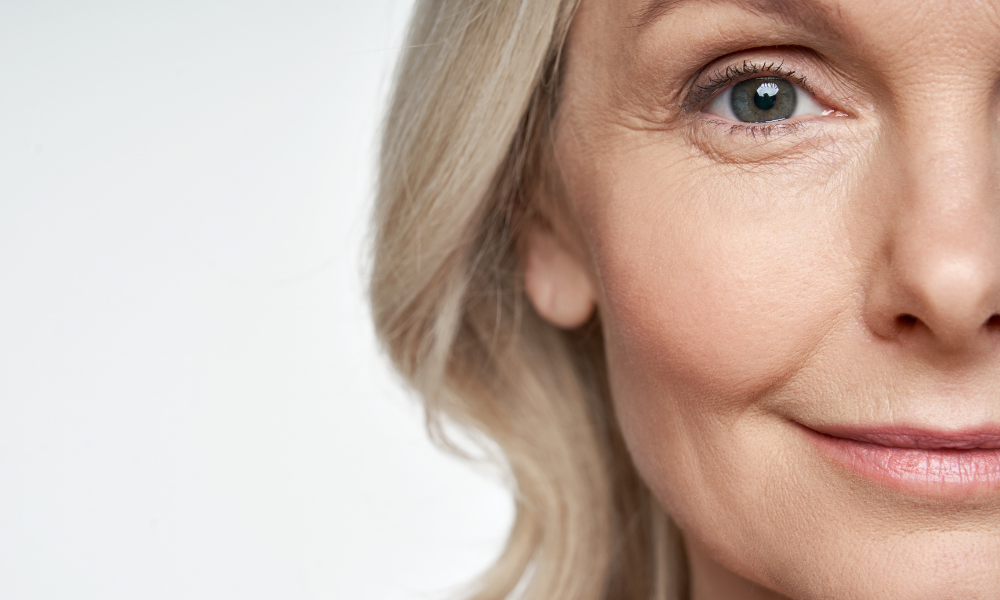April is National Rosacea Awareness Month
-
- Types of rosacea
- Triggers that may cause rosacea
- Treatments to minimize rosacea
- Featured rosacea skin care product
- Erythematotelangiectatic rosacea – Redness, flushing, visible blood vessels
- Papulopustular rosacea – Redness, swelling, and acne-like breakouts
- Phymatous rosacea – Skin thickens and has a bumpy texture, usually on the nose
- Ocular rosacea – Eyes red and inflamed, may feel dry and irritated
- Extreme hot or cold temperatures
- Excessive exposure to sunlight
- Drinking alcohol
- Eating spicy foods
- Certain ingredients in skin care products (alcohol, urea, fragrance, glycolic acid, sodium laurel sulfate, menthol, lactic acid, camphor)
- Prescription oral and topical products are effective and safe treatments for rosacea. Oral anti-inflammatory medication such as prescription doxycycline is effective in papulopustular rosacea and gold-standard treatment for ocular rosacea. Common prescriptions topical ingredients include anti-inflammatory medications such as metronidazole, and acaricidal agents such as ivermectin, and exfoliating ingredients such as azelaic acid.
- Over-the-counter anti-inflammatory products, including ingredients such as niacinamide
- Sun protection, daily SPF
- Surgical debunking of rhinophymatous changes of the nose
- Intense Pulse Light (IPL) laser-like treatments, typically recommended a series of treatments 2-4 weeks apart for significant reduction of redness and diminishment of blood vessels

1. Rosacea has Four Subtypes
Rosacea and acne can sometime become confused. Acne is mainly characterized by pimples, while the main characteristic of rosacea is redness. Additionally, acne usually begins at a younger age (between 15 and 25 years) while rosacea usually occurs after the age of 30. Both acne and rosacea sometimes have a chronic character, the right treatments and advice can calm the skin and make sure the symptoms stay away for a longer period of time. It is important that you visit with your board-certified dermatologist to be sure you have the correct diagnosis for proper treatment.
2. Rosacea Triggers
3. Dermatologist Recommended Treatments for Rosacea
Intense Pulsed Light (IPL) to Treat Rosacea
IPL uses controlled light in specific wavelengths to alleviate the inflammation, redness, pimples and uneven skin tones caused by rosacea. By treating the blood vessels causing rosacea the vascular response is diminished. We have seen dramatic results for patients with rosacea even in patients suffering with stinging and burning sensations. Depending on the severity of the symptoms results can be seen in 1-3 treatments.

See our board-certified dermatologists, Dr. Cera Hill or Dr. Ghiselli, for diagnosis and treatment options of rosacea.
Featured Product: Senté Dermal Repair Cream
Lightweight, deeply hydrating, and post procedure approved! Dermal Repair Cream is formulated with sensitive skin in mind. During the month of April, buy any Senté product with HSA and receive one mini two-week supply of Dermal Repair Cream or Dermal Repair UltraNourish as a gift from us.
 Clinical trials show reduced visible redness and sensitivity after only 4 weeks
Clinical trials show reduced visible redness and sensitivity after only 4 weeks Deeply hydrate and renew skin
Deeply hydrate and renew skin Promotes healthier, more even-looking skin
Promotes healthier, more even-looking skin Improvements in the appearance of fine lines and wrinkles
Improvements in the appearance of fine lines and wrinkles Recommended by 500+ dermatologists
Recommended by 500+ dermatologists
